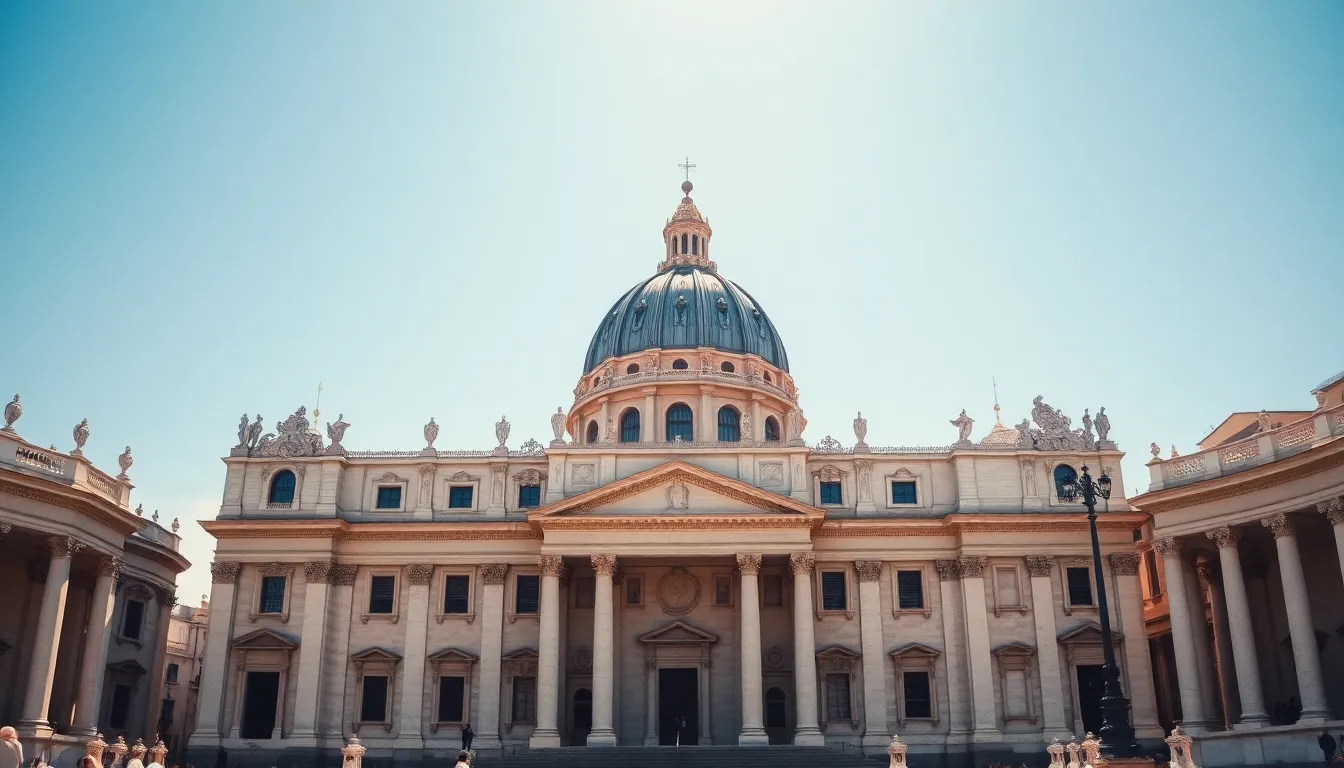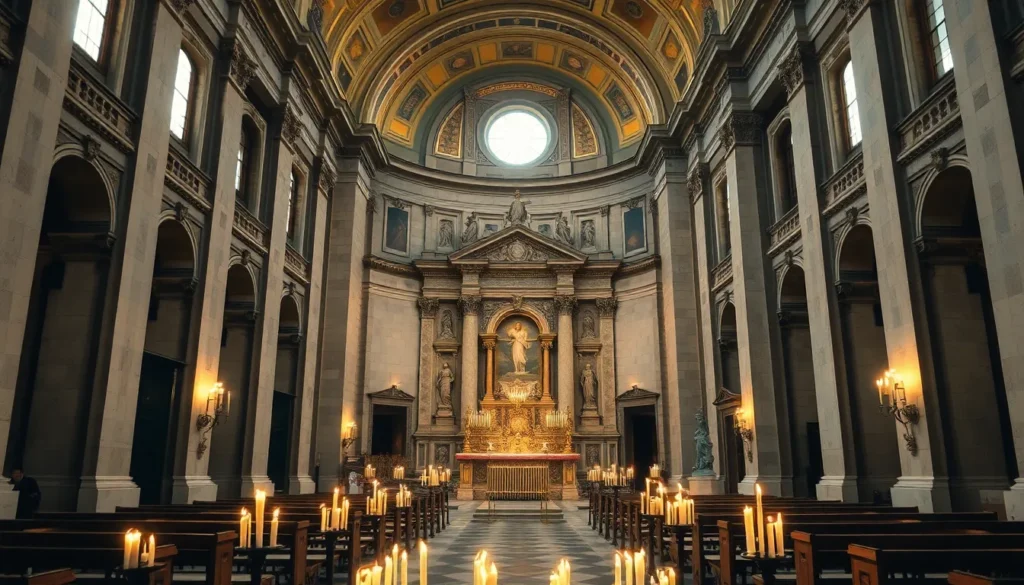When it comes to the final resting place of a pope, curiosity often leads to a mix of reverence and intrigue. After all, this isn’t just any burial; it’s a significant event steeped in tradition and history. So where will the next pontiff lay their head for eternity? Is it a cozy corner of St. Peter’s Basilica or perhaps a secret Vatican garden?
Table of Contents
ToggleHistorical Context of Papal Burials
Papal burials carry deep historical significance, reflecting centuries of tradition within the Catholic Church. Initially, early popes were buried in catacombs, emphasizing their martyrdom and connection to early Christianity. Over time, this practice evolved, with more recent popes interred in prominent locations within the Vatican, particularly St. Peter’s Basilica.
St. Peter’s Basilica stands as the most notable burial site, housing the remains of 91 popes. Construction of this iconic structure began in the 16th century and concluded in the 17th century, securing its status as a central place for honoring papal legacies. The site not only serves as a mausoleum but also as a pilgrimage destination, attracting millions annually.
Tradition influences burial customs, whereby each pope’s final resting place often reflects their papacy and contributions to the Church. Notable figures such as Pope John Paul II, buried in the Vatican grottos, exemplify this personalized approach to burial sites. Their locations carry symbolic significance, representing their life’s work and connection to the faithful.
Special ceremonies accompany each burial, further emphasizing the gravity of the moment. Family, cardinals, and dignitaries gather to pay respects, celebrating the pope’s service and legacy. These events draw international attention, underscoring the historical and spiritual weight of papal burials within Catholic tradition.
As the next papal burial approaches, speculation regarding the location remains high. Factors influencing the choice include historical precedents, the pope’s personal wishes, and church hierarchy practices. Each decision carries monumental implications for the faith community, blending reverence, history, and tradition into the fabric of Catholicism.
Current Pope’s Health and Legacy

Current discussions focus on the pope’s health and future legacy. As speculation surrounds potential burial sites, various factors influence choices.
Speculations on Future Burials
Speculation regarding future papal burials includes several likely locations. St. Peter’s Basilica remains a prominent option, given its historical significance and traditional use. Another possibility involves lesser-known sites within the Vatican grounds, which may align with the personal wishes of the pope. Decisions often reflect a pope’s contributions to the Church, ensuring that each burial site resonates with their legacy. Church hierarchy also plays a role, guiding the selection process while confirming adherence to long-standing traditions.
Impact on the Catholic Community
Impact on the Catholic community remains profound during these transitions. Each papal burial sparks emotional responses, aligning with the deep-rooted traditions of the faith. The church community often engages in memorial services, fostering unity and reflection. Popes serve as spiritual leaders, contributing to the collective identity of Catholics worldwide. Such events highlight the lasting influence these leaders hold, shaping both church doctrine and the lives of millions.
Traditional Burial Sites for Popes
Papal burial sites hold deep significance within the Catholic tradition. These locations reflect the legacy of each pope and their impact on the Church.
St. Peter’s Basilica
St. Peter’s Basilica serves as the principal burial site for popes. Located in Vatican City, this iconic church houses the remains of 91 popes, making it a prominent pilgrimage destination. Burial beneath the basilica signifies a pope’s influence and connection to St. Peter, the Church’s founder. Notable figures, including Pope John Paul II, rest here, further elevating the site’s importance. Special ceremonies accompany each interment, drawing pilgrims and dignitaries from around the globe. Such events highlight the spiritual weight associated with these papal burials.
Other Notable Locations
Beyond St. Peter’s Basilica, several alternative burial sites exist within the Vatican. The Vatican Grottoes, situated beneath the basilica, offer additional interment options for popes. Historically, catacombs served as burial grounds for early popes, emphasizing their martyrdom. Additionally, the Campo Verano cemetery in Rome sometimes welcomes popes for interment. Personal wishes and historical context influence these decisions. Other private chapels within the Vatican have also housed the remains of certain popes, reflecting their unique contributions to the Catholic faith. Each location carries its own history and significance, further enriching the narrative of papal burials.
Recent Developments in Papal Burials
Recent discussions highlight the evolving landscape of papal burials. Notably, Pope Francis expressed a preference for simplicity, which might influence future burial practices. Various reports indicate a shift toward more personal and meaningful locations, aligning with the pope’s values.
Experts speculate that if he passes, there could be a departure from longstanding traditions. Factors like historical significance and personal wishes may dictate burial sites more than in the past. Some suggest that the Vatican Grottoes might serve as a suitable resting place, reflecting both history and personal connections.
Changes in burial practices also encompass a broader acknowledgement of popes’ legacies. The notion of individualized memorial services has gained traction, resonating with current sentiments within the Church. Each pope’s burial now has a unique narrative, aiming to connect deeply with the community.
The increased focus on emotional resonance during memorial services is evident. These events might draw larger crowds, emphasizing unity within the Catholic community. A personalized approach to burials could foster connections with a wider audience, driving deeper engagement with the Church’s history.
Further developments in equipment and ceremony logistics are likely to improve how these significant events unfold. International attention on papal burials continues to heighten interest, prompting discussions about their future. As these trends progress, the next burial site may embody a balance of tradition and modernity, setting new precedents for ecclesiastical memorial practices.
The future of papal burials promises to be a blend of tradition and modernity. As the Catholic Church navigates the preferences of its leaders and the expectations of its followers, the choice of burial site will likely reflect a pope’s legacy and personal beliefs.
With ongoing discussions surrounding simplicity and personalization, the next burial could set new standards for how the Church honors its spiritual leaders. Each burial will continue to evoke deep emotional responses and foster unity among the faithful, ensuring that the legacy of the papacy remains a vital part of Catholic tradition.




